BEO6600: Efficiency Wages, Minimum Wage Rate, and 7-Eleven Analysis
VerifiedAdded on 2023/06/11
|8
|1564
|381
Report
AI Summary
This report explores the economic implications of minimum wage, particularly in the context of the efficiency wage theory. It examines the rationale behind minimum wage, highlighting potential benefits such as increased worker effort, reduced turnover, and improved worker quality and health. However, it also addresses the disadvantages, including involuntary unemployment and reduced competitiveness for labor-intensive industries. Using the 7-Eleven Australia case as a backdrop, the report offers strategic recommendations for new businesses to mitigate the challenges posed by high minimum wage rates, such as adopting labor-substituting technologies and optimizing labor costs to ensure profitability. Desklib offers a wide array of solved assignments for students.
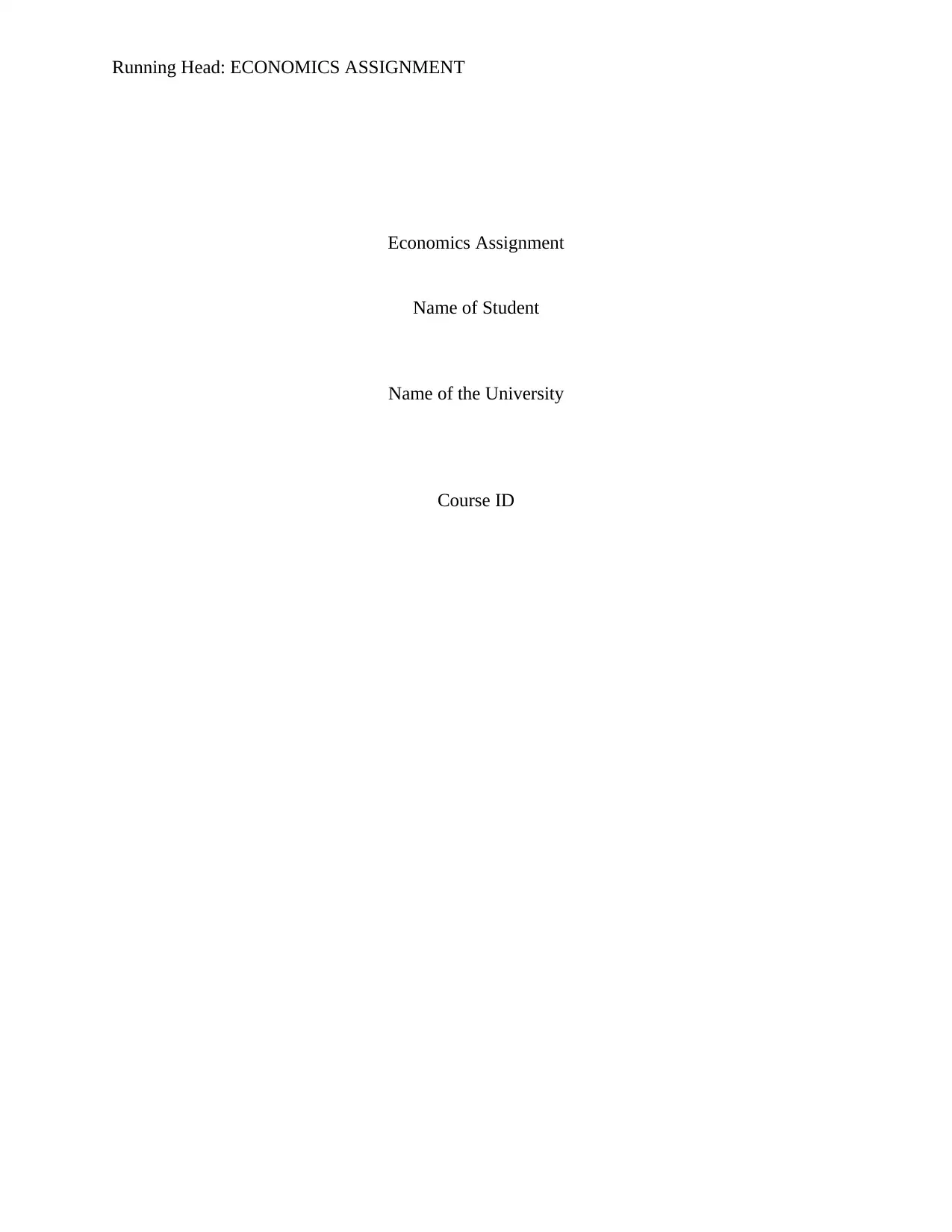
Running Head: ECONOMICS ASSIGNMENT
Economics Assignment
Name of Student
Name of the University
Course ID
Economics Assignment
Name of Student
Name of the University
Course ID
Paraphrase This Document
Need a fresh take? Get an instant paraphrase of this document with our AI Paraphraser
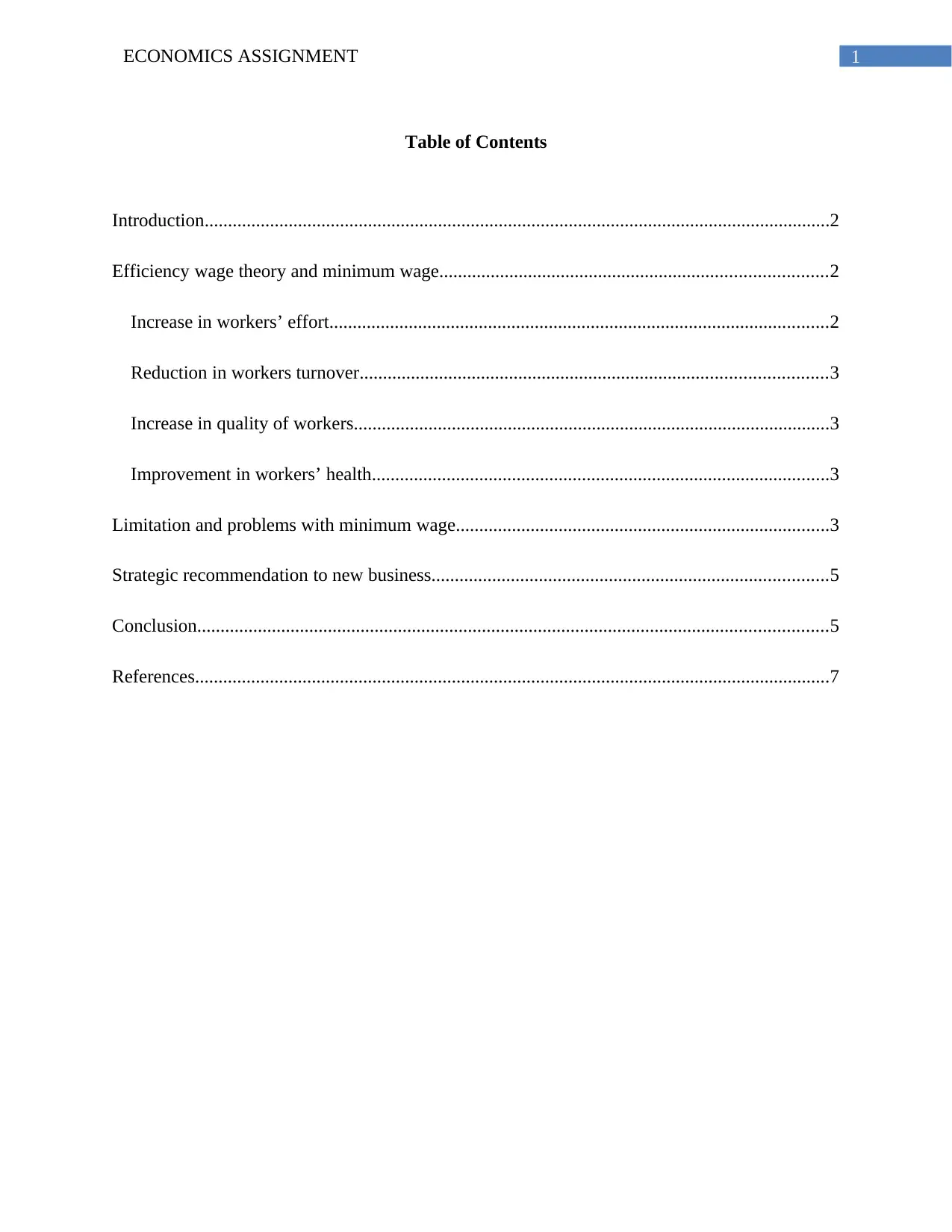
1ECONOMICS ASSIGNMENT
Table of Contents
Introduction......................................................................................................................................2
Efficiency wage theory and minimum wage...................................................................................2
Increase in workers’ effort...........................................................................................................2
Reduction in workers turnover....................................................................................................3
Increase in quality of workers......................................................................................................3
Improvement in workers’ health..................................................................................................3
Limitation and problems with minimum wage................................................................................3
Strategic recommendation to new business.....................................................................................5
Conclusion.......................................................................................................................................5
References........................................................................................................................................7
Table of Contents
Introduction......................................................................................................................................2
Efficiency wage theory and minimum wage...................................................................................2
Increase in workers’ effort...........................................................................................................2
Reduction in workers turnover....................................................................................................3
Increase in quality of workers......................................................................................................3
Improvement in workers’ health..................................................................................................3
Limitation and problems with minimum wage................................................................................3
Strategic recommendation to new business.....................................................................................5
Conclusion.......................................................................................................................................5
References........................................................................................................................................7
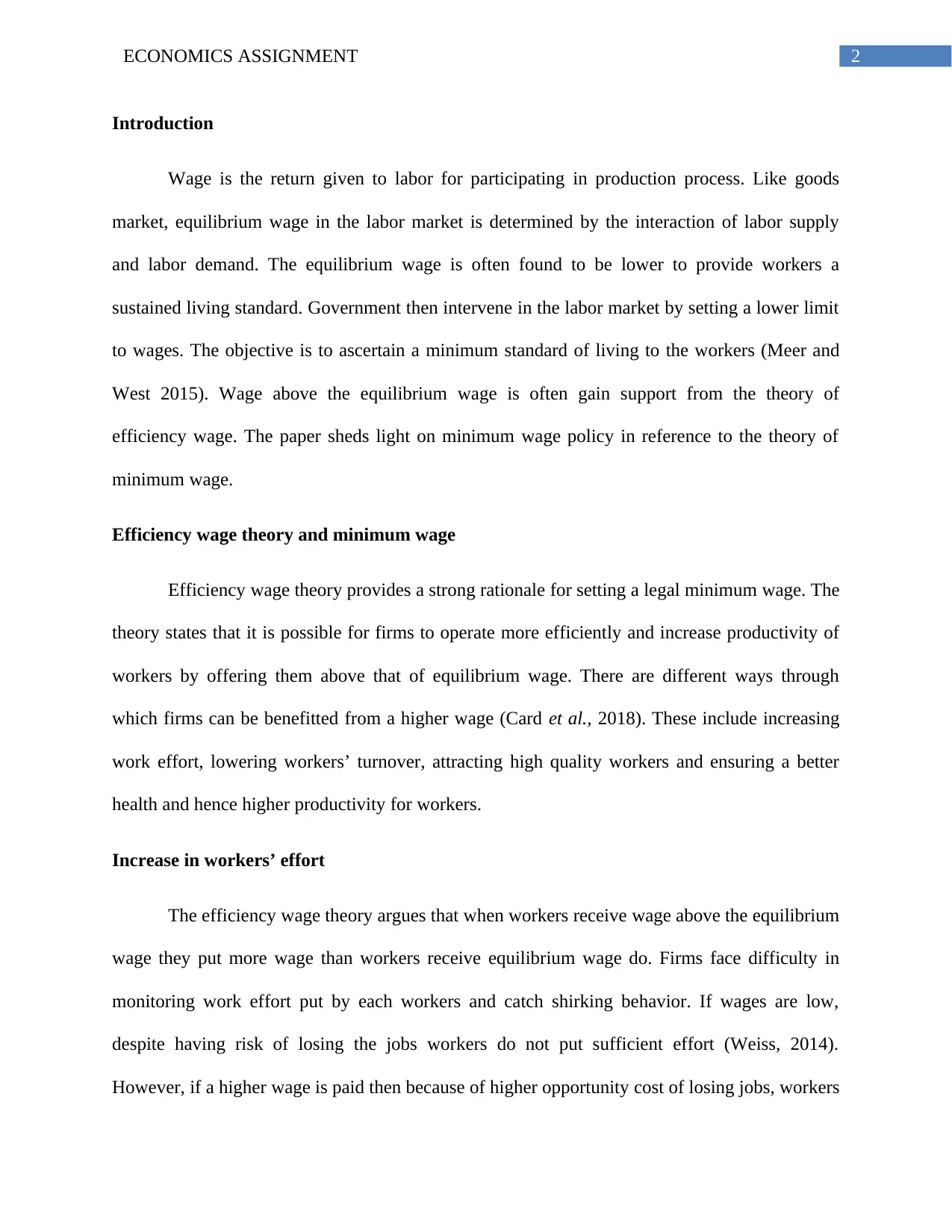
2ECONOMICS ASSIGNMENT
Introduction
Wage is the return given to labor for participating in production process. Like goods
market, equilibrium wage in the labor market is determined by the interaction of labor supply
and labor demand. The equilibrium wage is often found to be lower to provide workers a
sustained living standard. Government then intervene in the labor market by setting a lower limit
to wages. The objective is to ascertain a minimum standard of living to the workers (Meer and
West 2015). Wage above the equilibrium wage is often gain support from the theory of
efficiency wage. The paper sheds light on minimum wage policy in reference to the theory of
minimum wage.
Efficiency wage theory and minimum wage
Efficiency wage theory provides a strong rationale for setting a legal minimum wage. The
theory states that it is possible for firms to operate more efficiently and increase productivity of
workers by offering them above that of equilibrium wage. There are different ways through
which firms can be benefitted from a higher wage (Card et al., 2018). These include increasing
work effort, lowering workers’ turnover, attracting high quality workers and ensuring a better
health and hence higher productivity for workers.
Increase in workers’ effort
The efficiency wage theory argues that when workers receive wage above the equilibrium
wage they put more wage than workers receive equilibrium wage do. Firms face difficulty in
monitoring work effort put by each workers and catch shirking behavior. If wages are low,
despite having risk of losing the jobs workers do not put sufficient effort (Weiss, 2014).
However, if a higher wage is paid then because of higher opportunity cost of losing jobs, workers
Introduction
Wage is the return given to labor for participating in production process. Like goods
market, equilibrium wage in the labor market is determined by the interaction of labor supply
and labor demand. The equilibrium wage is often found to be lower to provide workers a
sustained living standard. Government then intervene in the labor market by setting a lower limit
to wages. The objective is to ascertain a minimum standard of living to the workers (Meer and
West 2015). Wage above the equilibrium wage is often gain support from the theory of
efficiency wage. The paper sheds light on minimum wage policy in reference to the theory of
minimum wage.
Efficiency wage theory and minimum wage
Efficiency wage theory provides a strong rationale for setting a legal minimum wage. The
theory states that it is possible for firms to operate more efficiently and increase productivity of
workers by offering them above that of equilibrium wage. There are different ways through
which firms can be benefitted from a higher wage (Card et al., 2018). These include increasing
work effort, lowering workers’ turnover, attracting high quality workers and ensuring a better
health and hence higher productivity for workers.
Increase in workers’ effort
The efficiency wage theory argues that when workers receive wage above the equilibrium
wage they put more wage than workers receive equilibrium wage do. Firms face difficulty in
monitoring work effort put by each workers and catch shirking behavior. If wages are low,
despite having risk of losing the jobs workers do not put sufficient effort (Weiss, 2014).
However, if a higher wage is paid then because of higher opportunity cost of losing jobs, workers
⊘ This is a preview!⊘
Do you want full access?
Subscribe today to unlock all pages.

Trusted by 1+ million students worldwide
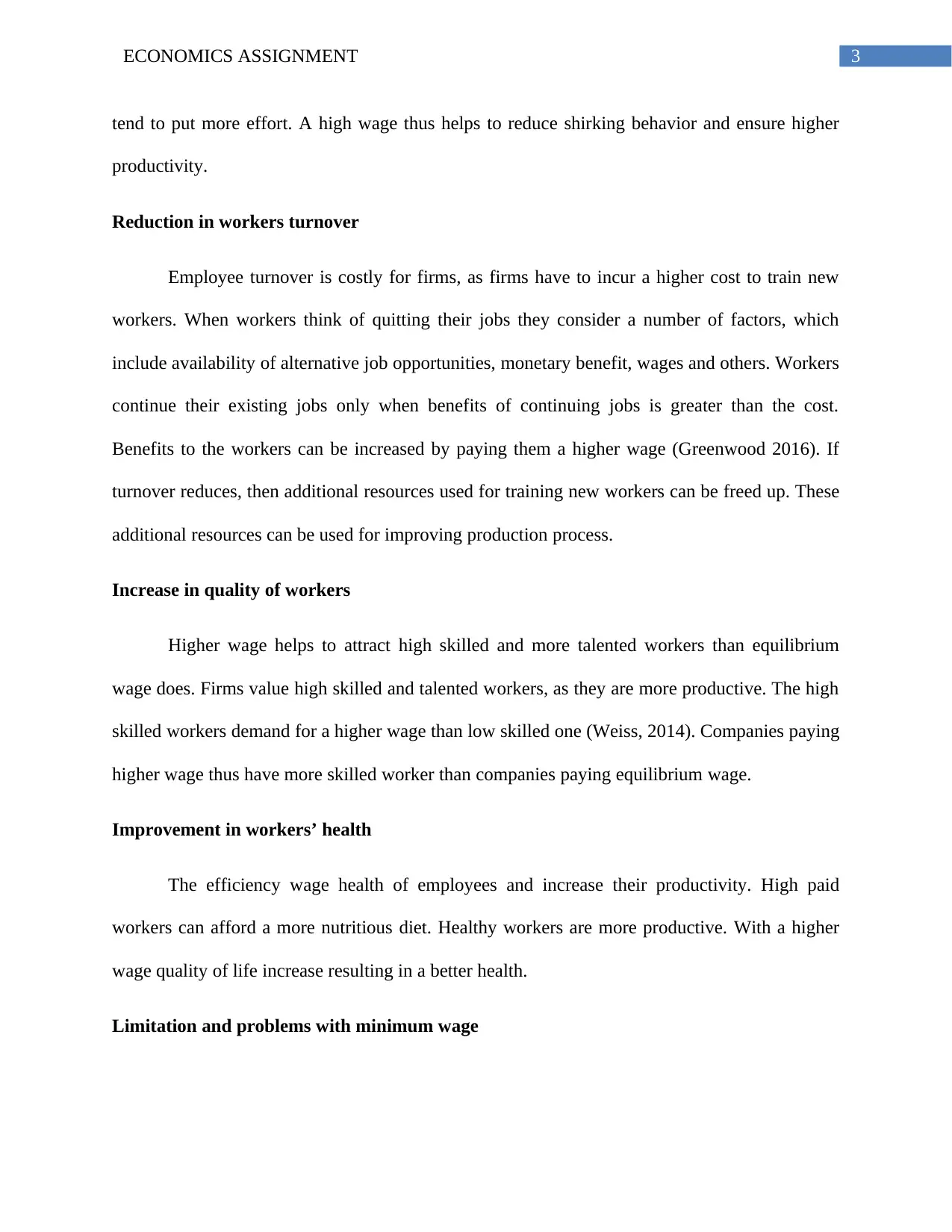
3ECONOMICS ASSIGNMENT
tend to put more effort. A high wage thus helps to reduce shirking behavior and ensure higher
productivity.
Reduction in workers turnover
Employee turnover is costly for firms, as firms have to incur a higher cost to train new
workers. When workers think of quitting their jobs they consider a number of factors, which
include availability of alternative job opportunities, monetary benefit, wages and others. Workers
continue their existing jobs only when benefits of continuing jobs is greater than the cost.
Benefits to the workers can be increased by paying them a higher wage (Greenwood 2016). If
turnover reduces, then additional resources used for training new workers can be freed up. These
additional resources can be used for improving production process.
Increase in quality of workers
Higher wage helps to attract high skilled and more talented workers than equilibrium
wage does. Firms value high skilled and talented workers, as they are more productive. The high
skilled workers demand for a higher wage than low skilled one (Weiss, 2014). Companies paying
higher wage thus have more skilled worker than companies paying equilibrium wage.
Improvement in workers’ health
The efficiency wage health of employees and increase their productivity. High paid
workers can afford a more nutritious diet. Healthy workers are more productive. With a higher
wage quality of life increase resulting in a better health.
Limitation and problems with minimum wage
tend to put more effort. A high wage thus helps to reduce shirking behavior and ensure higher
productivity.
Reduction in workers turnover
Employee turnover is costly for firms, as firms have to incur a higher cost to train new
workers. When workers think of quitting their jobs they consider a number of factors, which
include availability of alternative job opportunities, monetary benefit, wages and others. Workers
continue their existing jobs only when benefits of continuing jobs is greater than the cost.
Benefits to the workers can be increased by paying them a higher wage (Greenwood 2016). If
turnover reduces, then additional resources used for training new workers can be freed up. These
additional resources can be used for improving production process.
Increase in quality of workers
Higher wage helps to attract high skilled and more talented workers than equilibrium
wage does. Firms value high skilled and talented workers, as they are more productive. The high
skilled workers demand for a higher wage than low skilled one (Weiss, 2014). Companies paying
higher wage thus have more skilled worker than companies paying equilibrium wage.
Improvement in workers’ health
The efficiency wage health of employees and increase their productivity. High paid
workers can afford a more nutritious diet. Healthy workers are more productive. With a higher
wage quality of life increase resulting in a better health.
Limitation and problems with minimum wage
Paraphrase This Document
Need a fresh take? Get an instant paraphrase of this document with our AI Paraphraser
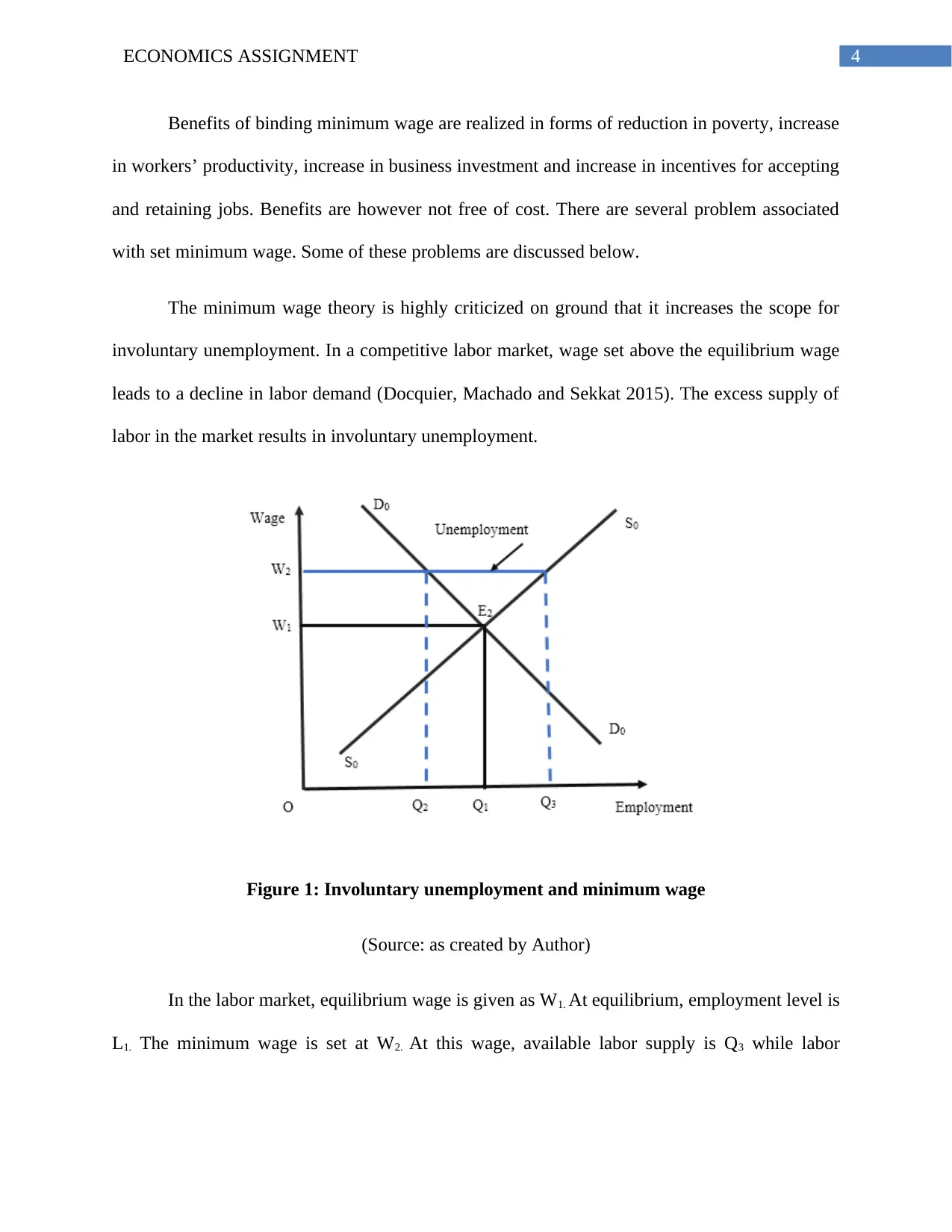
4ECONOMICS ASSIGNMENT
Benefits of binding minimum wage are realized in forms of reduction in poverty, increase
in workers’ productivity, increase in business investment and increase in incentives for accepting
and retaining jobs. Benefits are however not free of cost. There are several problem associated
with set minimum wage. Some of these problems are discussed below.
The minimum wage theory is highly criticized on ground that it increases the scope for
involuntary unemployment. In a competitive labor market, wage set above the equilibrium wage
leads to a decline in labor demand (Docquier, Machado and Sekkat 2015). The excess supply of
labor in the market results in involuntary unemployment.
Figure 1: Involuntary unemployment and minimum wage
(Source: as created by Author)
In the labor market, equilibrium wage is given as W1. At equilibrium, employment level is
L1. The minimum wage is set at W2. At this wage, available labor supply is Q3 while labor
Benefits of binding minimum wage are realized in forms of reduction in poverty, increase
in workers’ productivity, increase in business investment and increase in incentives for accepting
and retaining jobs. Benefits are however not free of cost. There are several problem associated
with set minimum wage. Some of these problems are discussed below.
The minimum wage theory is highly criticized on ground that it increases the scope for
involuntary unemployment. In a competitive labor market, wage set above the equilibrium wage
leads to a decline in labor demand (Docquier, Machado and Sekkat 2015). The excess supply of
labor in the market results in involuntary unemployment.
Figure 1: Involuntary unemployment and minimum wage
(Source: as created by Author)
In the labor market, equilibrium wage is given as W1. At equilibrium, employment level is
L1. The minimum wage is set at W2. At this wage, available labor supply is Q3 while labor
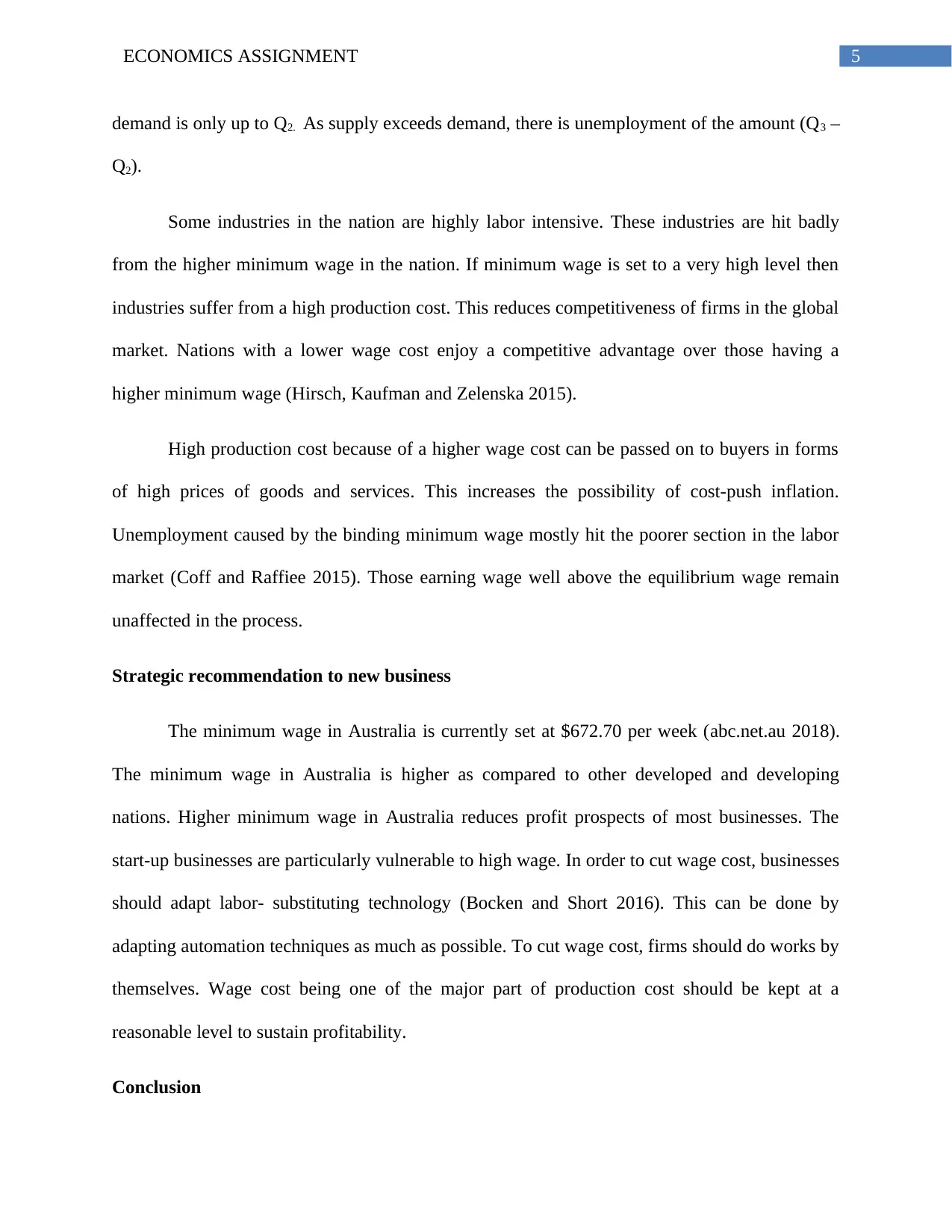
5ECONOMICS ASSIGNMENT
demand is only up to Q2. As supply exceeds demand, there is unemployment of the amount (Q3 –
Q2).
Some industries in the nation are highly labor intensive. These industries are hit badly
from the higher minimum wage in the nation. If minimum wage is set to a very high level then
industries suffer from a high production cost. This reduces competitiveness of firms in the global
market. Nations with a lower wage cost enjoy a competitive advantage over those having a
higher minimum wage (Hirsch, Kaufman and Zelenska 2015).
High production cost because of a higher wage cost can be passed on to buyers in forms
of high prices of goods and services. This increases the possibility of cost-push inflation.
Unemployment caused by the binding minimum wage mostly hit the poorer section in the labor
market (Coff and Raffiee 2015). Those earning wage well above the equilibrium wage remain
unaffected in the process.
Strategic recommendation to new business
The minimum wage in Australia is currently set at $672.70 per week (abc.net.au 2018).
The minimum wage in Australia is higher as compared to other developed and developing
nations. Higher minimum wage in Australia reduces profit prospects of most businesses. The
start-up businesses are particularly vulnerable to high wage. In order to cut wage cost, businesses
should adapt labor- substituting technology (Bocken and Short 2016). This can be done by
adapting automation techniques as much as possible. To cut wage cost, firms should do works by
themselves. Wage cost being one of the major part of production cost should be kept at a
reasonable level to sustain profitability.
Conclusion
demand is only up to Q2. As supply exceeds demand, there is unemployment of the amount (Q3 –
Q2).
Some industries in the nation are highly labor intensive. These industries are hit badly
from the higher minimum wage in the nation. If minimum wage is set to a very high level then
industries suffer from a high production cost. This reduces competitiveness of firms in the global
market. Nations with a lower wage cost enjoy a competitive advantage over those having a
higher minimum wage (Hirsch, Kaufman and Zelenska 2015).
High production cost because of a higher wage cost can be passed on to buyers in forms
of high prices of goods and services. This increases the possibility of cost-push inflation.
Unemployment caused by the binding minimum wage mostly hit the poorer section in the labor
market (Coff and Raffiee 2015). Those earning wage well above the equilibrium wage remain
unaffected in the process.
Strategic recommendation to new business
The minimum wage in Australia is currently set at $672.70 per week (abc.net.au 2018).
The minimum wage in Australia is higher as compared to other developed and developing
nations. Higher minimum wage in Australia reduces profit prospects of most businesses. The
start-up businesses are particularly vulnerable to high wage. In order to cut wage cost, businesses
should adapt labor- substituting technology (Bocken and Short 2016). This can be done by
adapting automation techniques as much as possible. To cut wage cost, firms should do works by
themselves. Wage cost being one of the major part of production cost should be kept at a
reasonable level to sustain profitability.
Conclusion
⊘ This is a preview!⊘
Do you want full access?
Subscribe today to unlock all pages.

Trusted by 1+ million students worldwide
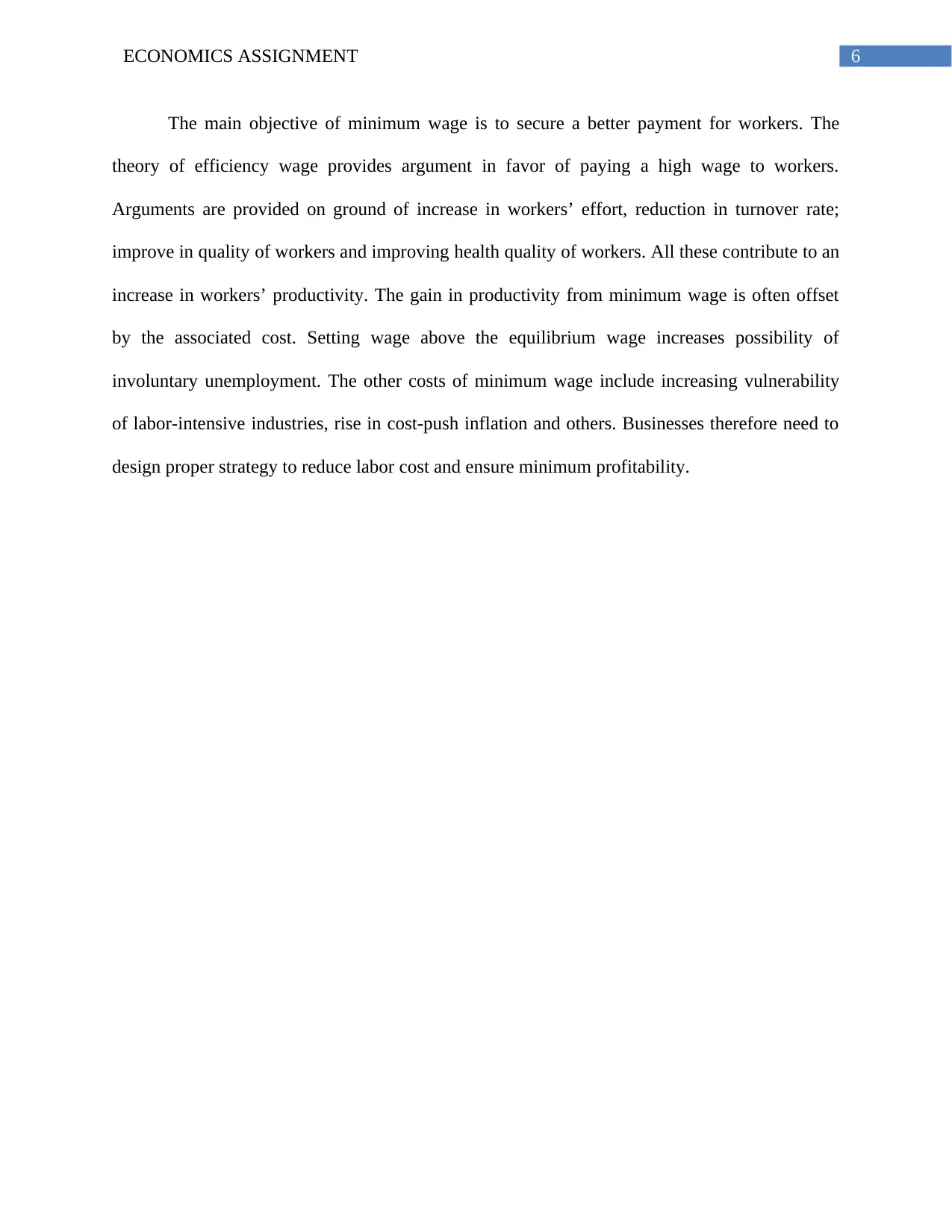
6ECONOMICS ASSIGNMENT
The main objective of minimum wage is to secure a better payment for workers. The
theory of efficiency wage provides argument in favor of paying a high wage to workers.
Arguments are provided on ground of increase in workers’ effort, reduction in turnover rate;
improve in quality of workers and improving health quality of workers. All these contribute to an
increase in workers’ productivity. The gain in productivity from minimum wage is often offset
by the associated cost. Setting wage above the equilibrium wage increases possibility of
involuntary unemployment. The other costs of minimum wage include increasing vulnerability
of labor-intensive industries, rise in cost-push inflation and others. Businesses therefore need to
design proper strategy to reduce labor cost and ensure minimum profitability.
The main objective of minimum wage is to secure a better payment for workers. The
theory of efficiency wage provides argument in favor of paying a high wage to workers.
Arguments are provided on ground of increase in workers’ effort, reduction in turnover rate;
improve in quality of workers and improving health quality of workers. All these contribute to an
increase in workers’ productivity. The gain in productivity from minimum wage is often offset
by the associated cost. Setting wage above the equilibrium wage increases possibility of
involuntary unemployment. The other costs of minimum wage include increasing vulnerability
of labor-intensive industries, rise in cost-push inflation and others. Businesses therefore need to
design proper strategy to reduce labor cost and ensure minimum profitability.
Paraphrase This Document
Need a fresh take? Get an instant paraphrase of this document with our AI Paraphraser
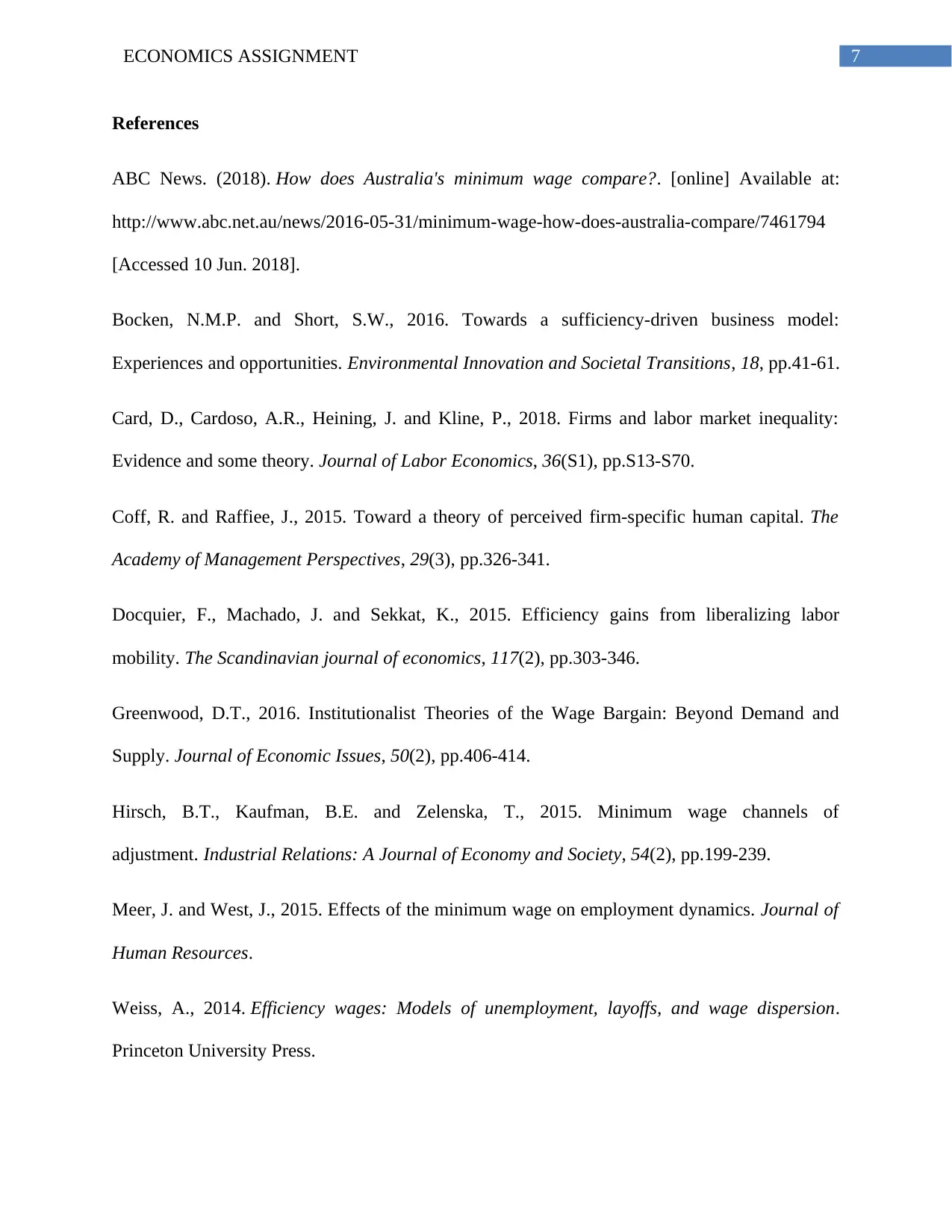
7ECONOMICS ASSIGNMENT
References
ABC News. (2018). How does Australia's minimum wage compare?. [online] Available at:
http://www.abc.net.au/news/2016-05-31/minimum-wage-how-does-australia-compare/7461794
[Accessed 10 Jun. 2018].
Bocken, N.M.P. and Short, S.W., 2016. Towards a sufficiency-driven business model:
Experiences and opportunities. Environmental Innovation and Societal Transitions, 18, pp.41-61.
Card, D., Cardoso, A.R., Heining, J. and Kline, P., 2018. Firms and labor market inequality:
Evidence and some theory. Journal of Labor Economics, 36(S1), pp.S13-S70.
Coff, R. and Raffiee, J., 2015. Toward a theory of perceived firm-specific human capital. The
Academy of Management Perspectives, 29(3), pp.326-341.
Docquier, F., Machado, J. and Sekkat, K., 2015. Efficiency gains from liberalizing labor
mobility. The Scandinavian journal of economics, 117(2), pp.303-346.
Greenwood, D.T., 2016. Institutionalist Theories of the Wage Bargain: Beyond Demand and
Supply. Journal of Economic Issues, 50(2), pp.406-414.
Hirsch, B.T., Kaufman, B.E. and Zelenska, T., 2015. Minimum wage channels of
adjustment. Industrial Relations: A Journal of Economy and Society, 54(2), pp.199-239.
Meer, J. and West, J., 2015. Effects of the minimum wage on employment dynamics. Journal of
Human Resources.
Weiss, A., 2014. Efficiency wages: Models of unemployment, layoffs, and wage dispersion.
Princeton University Press.
References
ABC News. (2018). How does Australia's minimum wage compare?. [online] Available at:
http://www.abc.net.au/news/2016-05-31/minimum-wage-how-does-australia-compare/7461794
[Accessed 10 Jun. 2018].
Bocken, N.M.P. and Short, S.W., 2016. Towards a sufficiency-driven business model:
Experiences and opportunities. Environmental Innovation and Societal Transitions, 18, pp.41-61.
Card, D., Cardoso, A.R., Heining, J. and Kline, P., 2018. Firms and labor market inequality:
Evidence and some theory. Journal of Labor Economics, 36(S1), pp.S13-S70.
Coff, R. and Raffiee, J., 2015. Toward a theory of perceived firm-specific human capital. The
Academy of Management Perspectives, 29(3), pp.326-341.
Docquier, F., Machado, J. and Sekkat, K., 2015. Efficiency gains from liberalizing labor
mobility. The Scandinavian journal of economics, 117(2), pp.303-346.
Greenwood, D.T., 2016. Institutionalist Theories of the Wage Bargain: Beyond Demand and
Supply. Journal of Economic Issues, 50(2), pp.406-414.
Hirsch, B.T., Kaufman, B.E. and Zelenska, T., 2015. Minimum wage channels of
adjustment. Industrial Relations: A Journal of Economy and Society, 54(2), pp.199-239.
Meer, J. and West, J., 2015. Effects of the minimum wage on employment dynamics. Journal of
Human Resources.
Weiss, A., 2014. Efficiency wages: Models of unemployment, layoffs, and wage dispersion.
Princeton University Press.
1 out of 8
Related Documents
Your All-in-One AI-Powered Toolkit for Academic Success.
+13062052269
info@desklib.com
Available 24*7 on WhatsApp / Email
![[object Object]](/_next/static/media/star-bottom.7253800d.svg)
Unlock your academic potential
Copyright © 2020–2025 A2Z Services. All Rights Reserved. Developed and managed by ZUCOL.





